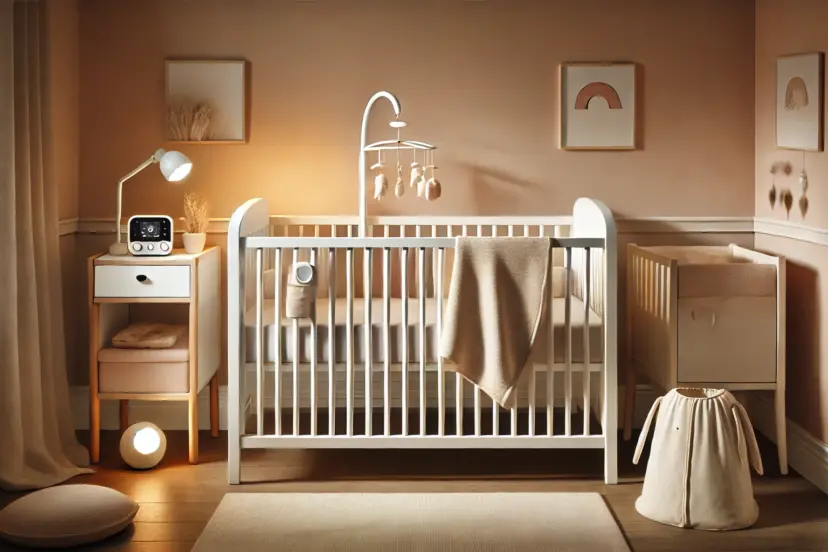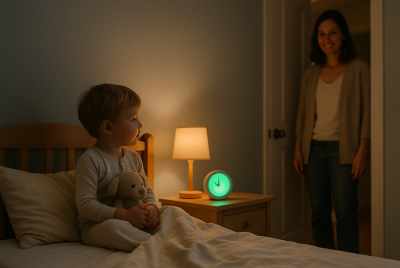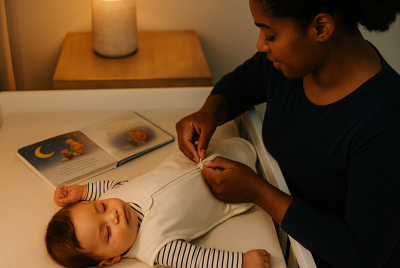Bassinet to Crib: A Smooth Transition for Your Little One
We may earn a commission for purchases made using our links. Please see our disclosure to learn more.
Moving your baby from a bassinet to a crib—it’s one of those parenting milestones that feels both thrilling and, let’s be real, a little daunting. There’s just something about this shift that seems so big, right? You’re not alone if you’re wondering how to make it as smooth as possible. I’ve been there, and trust me, there are some tips and tricks that can help.
Let’s walk through everything you need to know, from figuring out the timing to creating a cozy crib space your little one will love. By the end of this, you’ll be ready for a confident, comfy, crib-snoozing baby.
Why Move from a Bassinet to a Crib?
If you’re wondering why you need to move at all, that’s a solid question. Bassinets are perfectly snug for newborns, but as babies grow, they start to need more space. And unless you’ve got a baby-sized bassinet that magically grows with your kiddo (if only!), a crib gives them a safer, roomier place to sleep.
When Should You Make the Move?
Most parents start thinking about this transition when their babies are around 3-6 months old. If your baby’s starting to roll over, sit up, or just generally looks like a big fish in a small pond in that bassinet, it’s probably time to make the switch. (One day, they’ll be climbing out of that crib too, but let’s not go there yet.)
Signs Your Baby’s Ready for the Crib
So, how do you know if your baby’s ready? Simple: babies will show you. Maybe they’re waking up more often, looking restless, or seeming a bit cramped. If they’re moving around like they’re practicing gymnastics, it’s likely time for more space.
Picking the Right Crib
Not all cribs are created equal. You’ll want one that’s solid, meets safety standards, and has slats that aren’t too wide. Make sure it’s adjustable too—ideally, you can lower the mattress as your baby grows. This is going to be your baby’s new sleep home, so invest in something sturdy and safe.
Making the Crib Feel Cozy
Your baby’s been used to that warm, snug bassinet, so let’s try to bring some of that cozy magic to the crib. Start with a firm, snug-fitting mattress and a fitted sheet. (Hold off on blankets and toys in there, though—safety first!) The goal is to create a safe, cozy environment where your baby feels right at home.
Ease Into It: Start with Nap Times
Instead of moving straight to overnight crib sleep, start with naps in the crib during the day. That way, they can get used to it gradually. Once they’re napping there happily, you can start moving toward nighttime sleep. (Think of it like trying out a new bed in a hotel before committing to a full night.)
Establishing a Bedtime Routine
If you don’t already have a bedtime routine, now’s a great time to start one. It doesn’t have to be elaborate; maybe it’s a warm bath, a quick story, and a little lullaby. Over time, this routine will cue your baby that it’s time for sleep, and they’ll associate it with their new crib space.
Moving from Your Room to Their Own Room
If your baby’s been sleeping in your room, this can feel like a big leap (for you and them). Some parents like to start by placing the crib in their room for a few nights to ease the transition. Once everyone’s comfortable, you can move the crib to the nursery if that’s the end goal.
Handling Those First Nights of Separation Anxiety
Babies are pros at picking up on change, and a new crib might bring some nighttime fussiness. To help, try using a baby monitor so you can check in without actually going into the room. A little reassurance goes a long way in making them feel safe in their new space.
Crib Safety 101
When it comes to sleep safety, cribs beat bassinets for older babies every time. Just make sure the mattress fits snugly, avoid using blankets or stuffed animals in the crib, and always place your baby on their back to sleep. You can also stay updated on crib recalls—just in case.
What to Do if Your Baby Struggles with the Transition
Let’s be honest: sometimes, even with all the best tips, babies have off-nights. If your baby seems uncomfortable or restless, don’t stress. Give it a few more nights; if they’re still having a hard time, it might mean they need a bit more time to adjust.
Encouraging Self-Soothing
One of the biggest sleep gifts you can give your baby is the ability to self-soothe. If they start to stir, give them a moment to settle on their own before you jump in. Babies who learn to self-soothe tend to sleep longer and adjust more quickly to new environments.
Worries & What-Ifs: It’s All Normal!
Let’s be real—parents have all the concerns about this transition. Will my baby feel safe? Will they sleep through the night? If you’re stressing about these things, you’re definitely not alone. Most babies adapt quickly with a little time and patience (and maybe a few extra yawns from you).
Going Straight to a Toddler Bed?
Some parents wonder if they can skip the crib altogether and go for a toddler bed. While that’s possible, cribs tend to be the safest option for younger babies since they’re enclosed and prevent climbing. When they’re older and more independent, you can think about that toddler bed upgrade.
Choosing the Perfect Crib Mattress
A good crib mattress makes all the difference. Look for a firm, snug-fitting one that supports your baby’s little body. (It might not look the coziest to us adults, but babies actually do best on a firm mattress.)
Dealing with Night Waking During the Transition
A new sleeping environment can lead to more night waking at first. If your baby stirs, try comforting them without picking them up—just a gentle pat or soft “shhh” can do wonders. This helps them settle back down on their own.
Sleep Sacks: Yay or Nay?
Sleep sacks are a great alternative to loose blankets, especially for crib sleepers. They keep your baby cozy without any of the risks blankets bring. Just make sure it’s roomy enough to let them move around comfortably.
Consistency, Consistency, Consistency
Babies are creatures of habit, so keep things consistent. Try to put them to bed at the same time each night, follow the same bedtime routine, and use the same sleep space (no more bouncing back and forth between the bassinet and crib). The more predictable things are, the easier the transition will be.
Tune Into Your Baby’s Comfort
Not every baby’s the same, so watch how your baby reacts. If they seem extra fussy, maybe try a softer sheet, a lightweight sleep sack, or even a gentle crib-safe mobile to help them relax.
Parental Patience Goes a Long Way
Sometimes the only thing you really need is patience. You might have a few sleepless nights during this transition, but it’s all part of the process. Babies are sensitive to our energy, so try to stay calm—it’ll help them feel safe and secure.
Expect Some Ups and Downs
The first few nights might be a bit of a rollercoaster. You may even wonder if you made the right decision. But don’t worry—it’s all part of the journey. Little by little, your baby will become comfortable with their new sleep setup.
Avoid Comparing Your Baby’s Journey to Others’
It’s so tempting to compare, but every baby’s sleep journey is unique. Your friend’s baby might have taken to the crib like a pro, while yours needs a little more time. (That’s perfectly normal!) This transition is personal, so give it the attention it deserves.
Team Up with Your Partner
If you have a partner, work together on this. Taking turns with bedtime can help your baby get used to both of you during the nighttime routine. Plus, it’s nice to have someone to share the ups and downs with!
Celebrate the Small Wins
Did your baby sleep a full night in the crib? Or maybe they managed a good stretch of nap time in there? Celebrate it! These little milestones lead to bigger successes.
Trust Your Gut
You know your baby better than anyone. Trust yourself, and remember there’s no one-size-fits-all approach to this. The right method is the one that works best for you and your baby.
Key Research and Guidelines on Safely Transitioning Babies from Bassinet to Crib
American Academy of Pediatrics (AAP) Guidelines on Safe Sleep: The AAP recommends that infants sleep in the same room as their parents, but on a separate sleep surface, such as a crib or bassinet, for at least the first six months to reduce the risk of Sudden Infant Death Syndrome (SIDS). They advise against bed-sharing due to associated risks. The AAP also emphasizes the importance of using a firm sleep surface and keeping soft bedding out of the sleep area.
Consumer Product Safety Commission (CPSC) Crib Safety Standards: The CPSC provides detailed safety standards for cribs, including specifications on slat spacing, mattress fit, and the elimination of drop-side rails. These standards are designed to prevent injuries and ensure a safe sleeping environment as babies transition from bassinets to cribs.
National Institute of Child Health and Human Development (NICHD) Safe to Sleep Campaign: The NICHD’s Safe to Sleep campaign offers evidence-based recommendations on safe sleep practices, including the appropriate timing for transitioning from a bassinet to a crib. They highlight the importance of placing babies on their backs to sleep and ensuring the sleep area is free from soft objects and loose bedding.
Essential Products to Support a Smooth Bassinet-to-Crib Transition
When transitioning your baby from a bassinet to a crib, a few well-chosen products can make all the difference in creating a safe, comfortable, and soothing sleep environment. Here are some essential items that can help ease the move:
- Crib Mattress
A firm, supportive crib mattress is crucial for your baby’s safety and comfort. Look for one that fits snugly in the crib, leaving no gaps along the sides. Foam and innerspring options are both popular, but make sure it’s certified safe for infants, like those with GREENGUARD Gold or CertiPUR-US certifications. - Sleep Sack or Swaddle Transition Blanket
Since loose blankets are a safety no-no in cribs, sleep sacks or wearable blankets are great alternatives. They provide warmth without the risks associated with blankets and can help babies feel cozy and secure, much like they did in the bassinet. Swaddle transition blankets can also be useful if your baby is used to swaddling but is ready for a bit more freedom. - White Noise Machine
A white noise machine can be a soothing addition for babies adjusting to a new sleep environment. Many machines offer various sound options, from soft lullabies to gentle nature sounds, to help babies relax and settle into sleep. - Nightlight or Soft Nursery Lighting
A dim nightlight can be helpful for night checks or feedings without disrupting your baby’s sleep. Choose a soft, warm light that won’t be overly bright; many models have adjustable settings so you can set the perfect level for your nursery. - Baby Monitor
A reliable baby monitor can give you peace of mind while your little one adjusts to their new sleep space, especially if they’re moving to a separate room. Video monitors are popular choices as they let you check on your baby visually without entering the room, which can help reduce disruptions during light sleep cycles.
Wrapping Up: A Big Step for Both of You
The move from a bassinet to a crib is a big milestone, not just for your baby but for you too. With a little patience, consistency, and a lot of love, you’ll get through this transition together. Your little one will soon be happily snoozing in their new crib space, and you’ll get to enjoy watching them grow.
FAQs
When’s the best time to make the switch? Usually between 3-6 months. Watch for signs like rolling over or sitting up.
How can I make the crib feel more like the bassinet? A firm mattress, a cozy sleep sack, and a gradual introduction can help.
What if my baby has a hard time adjusting? It’s okay to take it slow. Try easing them in with nap times first, and stick to a bedtime routine.
Is it safe to put toys in the crib? Best to keep it simple with just a fitted sheet and sleep sack—no toys or blankets.
Can I keep my baby in the bassinet longer? It depends on their growth and mobility. If they seem cramped or are rolling over, a crib is a safer choice.




